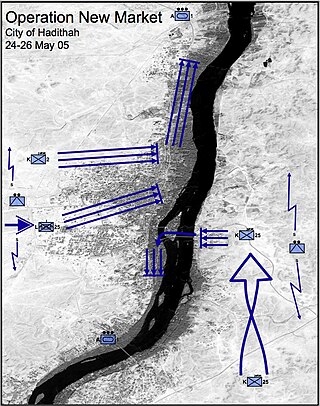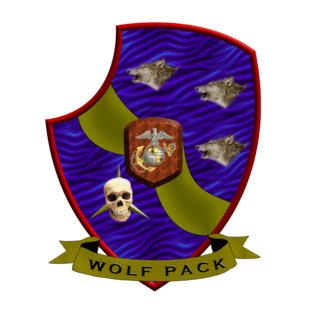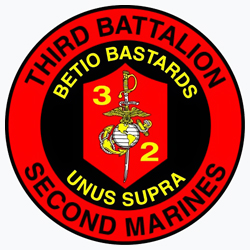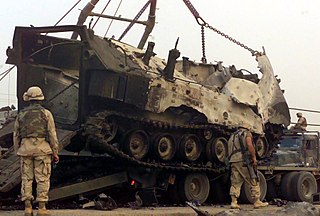
The Assault Amphibious Vehicle (AAV)—official designation AAVP-7A1 —is a fully tracked amphibious landing vehicle manufactured by U.S. Combat Systems.

The Second Battle of Fallujah, initially codenamed Operation Phantom Fury,Operation al-Fajr was an American-led offensive of the Iraq War that lasted roughly six weeks, starting 7 November 2004. Marking the highest point of the conflict against the Iraqi insurgency, it was a joint military effort carried out by the United States, the Iraqi Interim Government, and the United Kingdom. Within the city of Fallujah, the coalition was led by the U.S. Marine Corps and U.S. Army, the battle was later described as "some of the heaviest urban combat U.S. military have been involved in since the Battle of Huế City in Vietnam in 1968".

The 4th Marine Division is a reserve division in the United States Marine Corps. It was raised in 1943 for service during World War II, and subsequently fought in the Pacific against the Japanese. Deactivated after the war, the division was re-formed in 1966 and elements of the division deployed during the Gulf War in 1990–1991, as well as during the Iraq War. It is currently the ground combat element of the Marine Forces Reserve and is headquartered in New Orleans, Louisiana, and has units throughout the United States.

After the handover of sovereignty, Operation New Market was a sweep of an area near Haditha in western Iraq conducted by one thousand coalition and Iraqi Security Forces to rid the Euphrates river bank of anti-coalition forces. It was launched on 24 May 2005 and followed Operation Squeeze Play. New Market was followed by Operation Lightning. The operation was named after the famous US Civil War battle at New Market, VA where cadets from the Virginia Military Institute fought and some perished.

Haditha is a city in the western Iraqi Al Anbar Governorate, about 240 km (150 mi) northwest of Baghdad. It is a farming town situated on the Euphrates River at 34°08′23″N42°22′41″E. Its population of around 46,500 people, predominantly Sunni Muslim Arabs. The city lies near the Buhayrat al Qadisiyyah, an artificial lake which was created by the building of the Haditha Dam, the largest hydroelectric facility in Iraq.

The Battle of Abu Ghraib took place between Iraqi Mujahideen and United States forces at Abu Ghraib prison on April 2, 2005.

3rd Battalion, 1st Marines (3/1) is an infantry battalion in the United States Marine Corps based out of Camp Horno on Marine Corps Base Camp Pendleton, California. Nicknamed the "Thundering Third", the battalion consists of approximately 1,200 Marines and Sailors and falls under the command of the 1st Marine Regiment and the 1st Marine Division.

3d Light Armored Reconnaissance Battalion(3D LAR BN) is a fast and mobilized armored terrestrial reconnaissance battalion of the United States Marine Corps. Their primary weapon system is the LAV-25 and they are part of the 1st Marine Division and I Marine Expeditionary Force. The unit is based out of the Marine Corps Air Ground Combat Center Twentynine Palms, California.

3rd Battalion, 2nd Marines (3/2) is an infantry battalion in the United States Marine Corps based in Marine Corps Base Camp Lejeune, North Carolina. Comprising approximately 1000 marines and sailors and nicknamed the "Betio Bastards", they fall under the command of the 2nd Marine Regiment of the 2nd Marine Division.

3rd Battalion, 3rd Marines, abbreviated as (3/3), was an infantry battalion of the United States Marine Corps, based out of Kaneohe, Hawaii. Known as either "Trinity" or "America's Battalion", the unit normally fell under the command of the 3rd Marine Regiment of the 3rd Marine Division. When fully manned, the unit consisted of approximately 1000 U.S. Marines and United States Navy Sailors. Like most 20th century model infantry battalions of the U.S. Marine Corps, 3rd Battalion 3rd Marines was made up of three rifle companies, and a Headquarters and Services (H&S) company. The battalion was originally formed at Marine Corps Base Camp Lejeune, North Carolina in 1942 and saw action on both Bougainville and Guam during World War II, where it was awarded its first Presidential Unit Citation and Navy Unit Commendation. Marines in the battalion were also awarded one Medal of Honor and seven Navy Crosses during the war.

1st Battalion, 3rd Marines (1/3) is an infantry battalion in the United States Marine Corps based out of Marine Corps Base Hawaii. Nicknamed the "Lava Dogs", the battalion consists of approximately 800 Marines and sailors and falls under the command of the 3rd Marine Regiment of the 3rd Marine Division.

3rd Battalion, 24th Marines (3/24) was a reserve infantry battalion in the United States Marine Corps. The battalion was first formed in 1943 for service in the Pacific Theater of Operations during World War II, taking part in a number of significant battles including those at Saipan and Iwo Jima before being deactivated at the end of the war. In the early 1960s, the unit was reactivated as a reserve battalion. It was located throughout the Midwestern United States and consisted of approximately 800 marines and sailors. The battalion was part of the 24th Marine Regiment and the 4th Marine Division. Recent operations included tours in Iraq and Afghanistan. On May 19, 2013, the battalion was deactivated (retired) as a part of 2013 Marine Corps Force Restructuring, along with the 24th Marine Regiment. 3/24 personnel were reallocated to 23rd Marine Regiment, with the majority of the companies becoming 3rd Battalion, 23rd Marines.

The Haditha massacre was a series of killings on November 19, 2005, in which a group of United States Marines killed 24 unarmed Iraqi civilians. The killings occurred in the city of Haditha in Iraq's western province of Al Anbar. Among the dead were men, women, elderly people and children as young as 1, who were shot multiple times at close range while unarmed. The ensuing massacre took place after an improvised explosive device exploded near a convoy, killing a lance corporal and severely injuring two other marines. The immediate reaction was to seize 5 men in a nearby taxi and execute them on the street.

The Battle of Al-Qa'im was a military offensive conducted by the United States Marine Corps, against insurgent positions in Iraq's northwestern Anbar province, which ran from 8 May 2005 to 19 May 2005. It was focused on eliminating insurgents and foreign fighters in a region known as a smuggling route and a sanctuary for foreign fighters.

The Battle of Nasiriyah was fought between the US 2nd Marine Expeditionary Brigade and Iraqi forces from 23 March to 2 April 2003 during the US-led invasion of Iraq. On the night of 24–25 March, the bulk of the Marines of Regimental Combat Team 1 passed through the city over the bridges and attacked north towards Baghdad. However, fighting continued in the city until 1 April when Iraqi resistance in the city was defeated.
Al-Karmah, also sometimes transliterated as Karma, Karmah, or Garma, is a city in central Iraq, 16 km (10 mi) northeast of Fallujah in the province of Al Anbar.

The Anbar campaign consisted of fighting between the United States military, together with Iraqi security forces, and Sunni insurgents in the western Iraqi governorate of Al Anbar. The Iraq War lasted from 2003 to 2011, but the majority of the fighting and counterinsurgency campaign in Anbar took place between April 2004 and September 2007. Although the fighting initially featured heavy urban warfare primarily between insurgents and U.S. Marines, insurgents in later years focused on ambushing the American and Iraqi security forces with improvised explosive devices (IEDs), large scale attacks on combat outposts, and car bombings. Almost 9,000 Iraqis and 1,335 Americans were killed in the campaign, many in the Euphrates River Valley and the Sunni Triangle around the cities of Fallujah and Ramadi.

The Marine Raider Regiment (MRR), formerly known as the Marine Special Operations Regiment (MSOR), is a special operations force of the United States Marine Corps, which is a part of Marine Corps Special Operations Command (MARSOC). Renamed for its predecessor, the World War II Marine Raiders, this unit is the principal combat component of MARSOC, which is the Marine Corps' contribution to the United States Special Operations Command (USSOCOM).

Operation Al Majid was an operation conducted by both Marines and Iraqi security forces intended to disrupt and defeat insurgent activity throughout more than 30,000 square miles (78,000 km2) in western Al Anbar Province. The operation began in the fall of 2006 and resulted in a series of berms being constructed around the cities of Anah, Haditha, Haqlaniyah, and Barwanah.

Operation Sayeed also known as Operation Hunter in English, was a series of operations conducted in western Al Anbar Governorate by the United States Marine Corps in 2005. It was an umbrella operation, consisting of at least 11 named operations between July 2005 to December 2005. The purpose was to drive Al-Qaeda in Iraq forces from the Western Euphrates River Valley. Some parts of Operation Sayeed were Operation Steel Curtain and Operation Iron Fist.



















